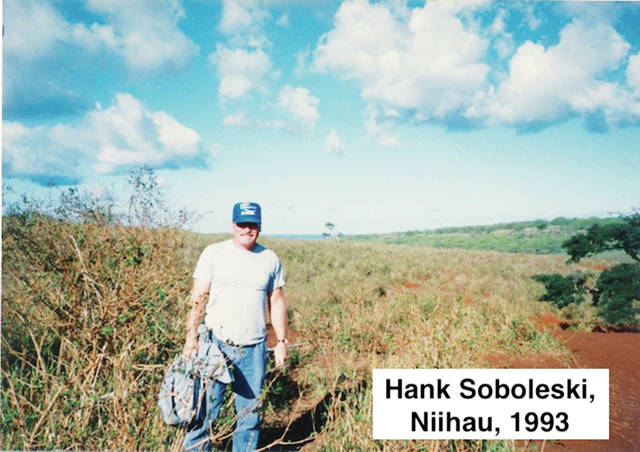During 1993, while employed as a USDA entomological technician, and with the permission of Niihau’s owners, Bruce and Keith Robinson, I had the privilege of visiting Niihau several times to assist entomologist Dr. Roger Vargas with his insect survey of the island.
On one day each month, helicopter pilot Tom Mishler would fly us from the Robinson helipad, situated mauka of Pakala, to 10 study sites established throughout the island of Niihau at Pakehoolua, Kauwawea, Apana Reservoir, Puuwai Village, Awanui, Aliaiki, Kamalino, Kiekie, Popolonui and Mt. Paniau.
Sometimes Keith or Bruce would be at the helipad talking in Hawaiian with Niihau employees, and a couple of times, we didn’t fly directly to Niihau, but flew to Burns Field first to take on Hawaiians returning home.
Our first stop on Niihau was Puuwai Village, where we would land on a grassy clearing just outside the village not far from the place Japanese pilot Shigenori Nishikaichi crash-landed on Dec. 7, 1941.
Hawaiians would greet each other there and food supplies would be dropped off.
Then a friendly young fellow would drive up in a vintage World War II army truck to take Dr. Vargas and myself to the Puuwai study site set in a house lot within the village — a quiet and most peaceful place.
From there were would fly to the nine remaining sites.
The Pakehoolua site was near Lehua Landing with Lehua Island visible about a kilometer offshore, and atop 1,280 foot Mt. Paniau, a panoramic view of Niihau lay before us.
Kiekie was the original homesite of Elizabeth Sinclair, the Scotswoman who purchased Niihau from Kamehameha V in 1864.
There, next to an old weatherbeaten house, stood a garage containing sea chests dating back to a bygone era.
Elsewhere, groups of men gathered kiawe from which they would make charcoal for sale, and women on the beach collected tiny seashells they fashioned into leis.
Beehive boxes were present then, and flocks of sheep roamed about the island.
Our day’s work done, we’d fly across the Kaulakahi Channel to Kauai.


